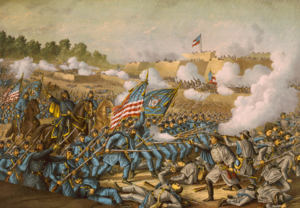Battle of Williamsburg
| Battle of Williamsburg (Battle of Fort Magruder) |
|||||||
|---|---|---|---|---|---|---|---|
| Part of the American Civil War | |||||||
 Battle of Williamsburg, by Kurz and Allison, 1893. |
|||||||
|
|||||||
| Belligerents | |||||||
|
|
|
||||||
| Commanders and leaders | |||||||
| George B. McClellan |
Joseph E. Johnston James Longstreet |
||||||
| Units involved | |||||||
| Army of the Potomac | Army of Northern Virginia | ||||||
| Strength | |||||||
| 40,768 | 31,823 | ||||||
| Casualties and losses | |||||||
| 2,283 | 1,682 | ||||||
The Battle of Williamsburg, also known as the Battle of Fort Magruder, took place on May 5, 1862, in York County, James City County, and Williamsburg, Virginia, as part of the Peninsula Campaign of the American Civil War. It was the first pitched battle of the Peninsula Campaign, in which nearly 41,000 Federals and 32,000 Confederates were engaged, fighting an inconclusive battle that ended with the Confederates continuing their withdrawal.
Following up the Confederate retreat from Yorktown, the Union division of Brig. Gen. Joseph Hooker encountered the Confederate rearguard near Williamsburg. Hooker assaulted Fort Magruder, an earthen fortification alongside the Williamsburg Road, but was repulsed. Confederate counterattacks, directed by Maj. Gen. James Longstreet, threatened to overwhelm the Union left flank, until Brig. Gen. Philip Kearny's division arrived to stabilize the Federal position. Brig. Gen. Winfield S. Hancock's brigade then moved to threaten the Confederate left flank, occupying two abandoned redoubts. The Confederates counterattacked unsuccessfully. Hancock's localized success was not exploited. The Confederate army continued its withdrawal during the night in the direction of Richmond, Virginia.
When Confederate General Joseph E. Johnston unexpectedly withdrew his forces from the Warwick Line at the Battle of Yorktown the night of May 3, Union Maj. Gen. George B. McClellan was taken by surprise and was unprepared to mount an immediate pursuit. On May 4, he ordered cavalry commander Brig. Gen. George Stoneman to pursue Johnson's rearguard and sent approximately half of his Army of the Potomac along behind Stoneman, under the command of Brig. Gen. Edwin V. Sumner. He also ordered Brig. Gen. William B. Franklin's division to board transport ships on the York River in an attempt to move upstream and land so as to cut off Johnston's retreat. However, it took two days just to board the men and equipment onto the ships, so the maneuver had no effect on the battle of May 5; Franklin's division landed and fought in the Battle of Eltham's Landing on May 7.
...
Wikipedia
